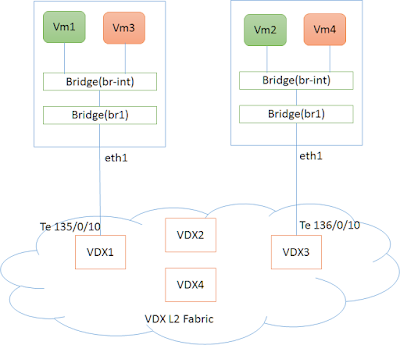Openstack Kuryr (Docker) Integration with Brocade VDX (AMPP)
Openstack kuryr is integrated with neutron. Kuryr provides a remote driver as per the contatiner Networking Model. Kuryr driver translates the libnetwork callbacks to appropriate neutron calls.
Here we are going to show case the integration of Kuryr with Brocade VDX Device
Setup of Openstack Plugin
Pre-requisites
Brocade Plugins require a specific version of ncclient (Net conf library). It can be obtained from the following github location.
git clone https://github.com/brocade/ncclient
cd ncclient
sudo python setup.py install
Install Brocade Plugin
git clone https://github.com/openstack/networking-brocade.git --branch=<stable/branch_name>
cd networking-brocade
sudo python setup.py install
Note: branch is an optional if the latest files(master branch) from the repository is required.
Upgrade the Database
Upgrade the database so that Brocade specific table entries are created in neutron database
neutron-db-manage --config-file /etc/neutron/neutron.conf
--config-file /etc/neutron/plugins/ml2/ml2_conf.ini upgrade head
Openstack Controller Configurations (L2 AMPP Setup)
Following configuration lines needs to be available in ‘/etc/neutron/plugins/ml2/ml2_conf.ini’ to start Brocade VDX Mechanism driver (brocade_vdx_vlan).
[ml2]
tenant_network_types = vlan
type_drivers = vlan
mechanism_drivers = openvswitch,brocade_vdx_ampp
[ml2_type_vlan]
network_vlan_ranges = physnet1:2:500
[ovs]
bridge_mappings = physnet1:br1
Here,
- mechanism driver needs to be set to ‘brocade_vdx_ampp’ along with openvswitch.
- ‘br1’ is the openvswith bridge.
- ‘2:500’ is the vlan range used
Following configuration lines for the VDX Fabric needs to be added to either ‘/etc/neutron/plugins/ml2/ml2_conf_brocade.ini’ or ‘/etc/neutron/plugins/ml2/ml2_conf.ini’.
If added to ‘/etc/neutron/plugins/ml2/ml2_conf_brocade.ini’ then this file should be given as config parameter during neutron-server startup.
[ml2_brocade]
username = admin
password = password
address = 10.37.18.139
ostype = NOS
physical_networks = physnet1
osversion=5.0.0
initialize_vcs = True
nretries = 5
ndelay = 10
nbackoff = 2
Here,
[ml2_brocade] - entries
- 10.37.18.139 is the VCS Virtual IP (IP for the L2 Fabric).
- osversion - NOS version on the L2 Fabric.
- nretries - number of netconf to the switch will be retried in case of failure
- ndelay - time delay in seconds between successive netconf commands in case of failure
Openstack Compute Configurations (L2 AMPP Setup)
Following configuration lines needs to be available in one of the configuration files used by openvswitch agent.
e.g /etc/neutron/plugins/openvswitch/ovs_neutron_plugin.ini
[ovs]
bridge_mappings = physnet1:br1
network_vlan_ranges = 2:500
tenant_network_type = vlan
Here,
- ‘br1’ is the openvswitch bridge.
- ‘2:500’ is the vlan range used
VDX Configurations
Put all the interfaces connected to compute node in port-profile mode. This is a one-time configuration. (Te 135/0/10 and Te 136/0/10 in the topology above).
sw0(config)# interface TenGigabitEthernet 135/0/10
sw0(conf-if-te-135/0/10)# port-profile-port
sw0(config)# interface TenGigabitEthernet 136/0/10
sw0(conf-if-te-136/0/10)# port-profile-port
Setup of Kuryr
Install Kuryr project on both compute and controller (each of the the host nodes)
sudo pip install https://github.com/openstack/kuryr.git
sudo pip install -r requirements.txt
sudo ./scripts/run_kuryr.sh
Update the ‘"/etc/kuryr/kuryr.conf’ to contain the following lines, kuryr driver is run in the global scope and neutron_uri is provided of the neutron server.
[DEFAULT]
capability_scope = global
[neutron_client]
# Neutron URL for accessing the network service. (string value)
neutron_uri = http://10.37.18.158:9696
Restart both the remote driver(stop the one started earlier in the above step) and the docker service
sudo ./scripts/run_kuryr.sh
sudo service docker restart
Docker CLI command
Create Network
Create a Docker Network called “black_network” on the docker swarm having the subnet 92.16.1.0/24
root@controller:~# docker_swarm network create --driver kuryr --subnet=92.16.1.0/24 --gateway=92.16.1.1 black_network
2e36e5ac17f2d4a3534678e58bc4920dbcd8653919a83ad52cbaa62057297a84
This creates a neutron network with segmentation id (vlan) 43
root@controller:~# neutron net-show kuryr-net-2e36e5ac
+---------------------------+----------------------------------------------------+
| Field | Value |
+---------------------------+----------------------------------------------------+
| admin_state_up | True |
| availability_zone_hints | |
| availability_zones | nova |
| created_at | 2016-05-12T11:16:55 |
| description | |
| id | 23beebb7-c4ec-41be-a12a-96f897b1dace |
| ipv4_address_scope | |
| ipv6_address_scope | |
| mtu | 1500 |
| name | kuryr-net-2e36e5ac |
| port_security_enabled | True |
| provider:network_type | vlan |
| provider:physical_network | physnet1 |
| provider:segmentation_id | 43 |
| router:external | False |
| shared | False |
| status | ACTIVE |
| subnets | 5072db88-54be-4be0-a39b-f52b60a674ef |
| tags | kuryr.net.uuid.uh:bcd8653919a83ad52cbaa62057297a84 |
| | kuryr.net.uuid.lh:2e36e5ac17f2d4a3534678e58bc4920d |
| tenant_id | 1035ac77d5904b0184af843e58c37665 |
| updated_at | 2016-05-12T11:16:56 |
+---------------------------+----------------------------------------------------+
This creates a port-profile on the switch with appropriate parameters.
sw0(config)# do show running-config port-profile openstack-profile-43
port-profile openstack-profile-43
vlan-profile
switchport
switchport mode trunk
switchport trunk allowed vlan add 43
!
!
port-profile openstack-profile-43 activate
Create Docker Containers
Create a docker container on both the nodes in the docker_swarm
root@controller:~# docker_swarm run -itd --name=black_1 --env="constraint:node==compute" --net=black_network busybox
8079c6f22d8985307541d8fb75b1296708638a9150e0334f2155572dba582176
root@controller:~# docker_swarm run -itd --name=black_2 --env="constraint:node==controller" --net=black_network busybox
f8b4257abcf39f3e2d45886d61663027208b6596555afd56f3e4d8e45d641759
sw0(config)# do show port-profile status
Port-Profile PPID Activated Associated MAC Interface
UpgradedVlanProfile 1 No None None
openstack-profile-43 2 Yes fa16.3e2b.38b6 Te 135/0/10
fa16.3ebf.796c Te 136/0/10
fa16.3ed6.7f0b Te 135/0/10
Ping between Containers
root@controller:~# docker_swarm attach black_1
/ # ifconfig
eth0 Link encap:Ethernet HWaddr FA:16:3E:BF:79:6C
inet addr:92.16.1.2 Bcast:0.0.0.0 Mask:255.255.255.0
inet6 addr: fe80::f816:3eff:febf:796c/64 Scope:Link
UP BROADCAST RUNNING MULTICAST MTU:1500 Metric:1
RX packets:52 errors:0 dropped:14 overruns:0 frame:0
TX packets:9 errors:0 dropped:0 overruns:0 carrier:0
collisions:0 txqueuelen:1000
RX bytes:5956 (5.8 KiB) TX bytes:738 (738.0 B)
lo Link encap:Local Loopback
inet addr:127.0.0.1 Mask:255.0.0.0
inet6 addr: ::1/128 Scope:Host
UP LOOPBACK RUNNING MTU:65536 Metric:1
RX packets:0 errors:0 dropped:0 overruns:0 frame:0
TX packets:0 errors:0 dropped:0 overruns:0 carrier:0
collisions:0 txqueuelen:0
RX bytes:0 (0.0 B) TX bytes:0 (0.0 B)
/ # ping 92.16.1.3
PING 92.16.1.3 (92.16.1.3): 56 data bytes
64 bytes from 92.16.1.3: seq=0 ttl=64 time=1.825 ms
64 bytes from 92.16.1.3: seq=1 ttl=64 time=0.819 ms
64 bytes from 92.16.1.3: seq=2 ttl=64 time=0.492 ms
64 bytes from 92.16.1.3: seq=3 ttl=64 time=0.458 ms
64 bytes from 92.16.1.3: seq=4 ttl=64 time=0.489 ms
64 bytes from 92.16.1.3: seq=5 ttl=64 time=0.480 ms
64 bytes from 92.16.1.3: seq=6 ttl=64 time=0.438 ms
64 bytes from 92.16.1.3: seq=7 ttl=64 time=0.501 ms




